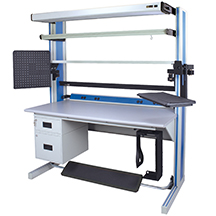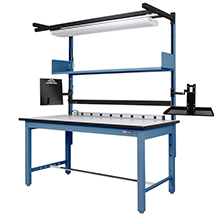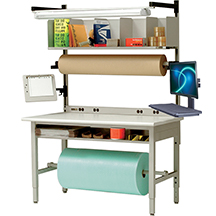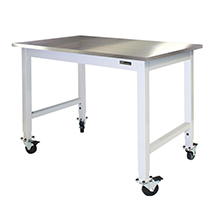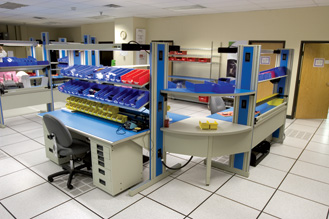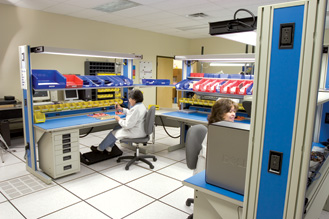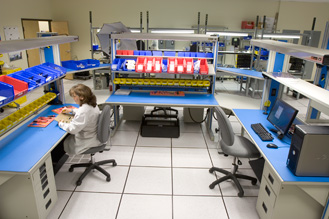iLASIK™ Maker Has a Clear Vision of Modern Manufacturing
Abbott Medical Optics Assembles a Modern Lab for Support of Its Latest Laser Eye Care System
The purpose of the following article is to provide a case study of the steps involved in furnishing a modern assembly lab, and to provide an enlightening roadmap for those faced with similar requirements. A successful project installation is result of those on the end-user side who know what they want to accomplish, and those on consultation and manufacturer side that know how to listen and place customer requirements first. Going into any job of this scope it is beneficial to have ideas and a clear direction, yet the flexibility to allow the ultimate realities of space, functionality and costs to shape final decisions. This case study is brought to you because all the persons involved worked towards a common goal, with final customer testimonials that include, "I cannot express enough how pleased everyone here is with your product and service. This is very high quality equipment, and assembly was easy due to the excellent design and forethought that went into building it. Everyone who has come through our production bay has been very impressed. Kudos to all involved." So, let's review those involved and what they provided to the success.
The Customer
Abbott Medical Optics (AMO) is the world's No. 1 laser vision correction company. They take their business extremely seriously, as you can expect from the leader in WaveFront technology, laser refractive surgery, and intraocular lens manufacturing. The company's new iLASIK™ procedure encompasses equipment for precise measurement and three-dimensional mapping of the eye, separate lasers for corneal flap creation and vision correction, and the guidance systems that marry the measurement and laser actions. iLASIK™ is designed to bring beginning-to-end vision correction that is 100 percent tailor-made to the unique characteristics found in each patient's eyes.
This year AMO applied their diligent approach as they sourced the equipment to furnish their WaveFront Sciences laboratory and manufacturing facility in Albuquerque, New Mexico. This facility is where the iDesign™ portion of iLASIK™ system is developed and manufactured. iDesign™ is the WaveFront Aberrometer that produces three dimensional eye mapping for generating the corrective prescriptions used in the iLASIK™ laser correction procedure.
It's not surprising that with the level of precision and sophistication found in AMO's iDesign™ WaveFront Aberrometer that they would look for similar qualities in the equipment with which they are manufactured. In setting up the new iDesign™ lab in Albuquerque, Mr. Keith Ratté was tasked with designing and equipping a completely new assembly and test environment.
Ratté's first decision was to furnish the assembly lab with modular workstations rather than built-in static casework. "We go into this introduction of a new generation of products with the expectation of growth and change. We have to keep our assembly lab flexible to accommodate future requirements and product enhancements," reports Ratté.
The Consultant
To provide guidance on the selection and set up of modular assembly workstations, Mr. Ratté called on Shannon Kieser of Techni-Tool Inc. in Mesa, Arizona. Together they reviewed a number of potential workstation designs, finally deciding on the Dimension 4 Workstations from IAC LLC in Brea, California.
Mr. Ratté is an accomplished and capable manager and planner. Why not just pick equipment manufacturers and begin ordering? The short answer is awareness of limitations in your own knowledge. The difference in lab furnishing equipment, even among products offered by a single vendor, is subtle and often confusing. A consultant experienced in facility design and workflow efficiency can help avoid costly errors, and more importantly, can provide a quicker route to a successful solution. Ms. Kieser, in the case of AMO, brought a thorough knowledge of the modular workstation capabilities and installation needed to shape a rapid plan, and bridged the communications with the sales and engineering departments at the equipment manufacturer, IAC LLC. In addition to helping to create the ultimate design, Kieser's involvement allowed Mr. Ratté to continue focusing on the daily management of an operating facility.
The Manufacturer
IAC LLC (IAC), of Brea, California, states their mission as the improvement of organization, function and atmosphere of their customers' production and assembly work areas, inspection stations, and research laboratories. IAC approaches this mission through such innovations as multi-part extruded aluminum uprights used on their Dimension 4 workstations, their unique Power Distribution System for versatile power control (of key import to the AMO installation), and through the employment of a certified ergonomist to assure maximum usability in their designs. IAC workstations have been developed to deliver improved efficiency anywhere workers are either seated or standing on the job. IAC's modular Dimension 4 workstations were selected by AMO after an exhaustive examination of all the choices available to them.
The Process–120 days to Launch
Questions, questions, questions—Answers! While Keith Ratté is busy asking questions of the various potential equipment vendors, in the case of IAC a flurry of questions come back. This is obviously a critical time, and if potential vendors aren't questioning you, you probably aren't being taken seriously. Questions about space, physical requirements of the assembly product, operator motion, material transfer and how the ergonomics of the work flow are going to be handled must be asked and answered to achieve the most productive end.
During this process with AMO, several preconceived notions on how the assembly cells would function were jettisoned. The team of customer, consultant and manufacturer worked together solve snags and other critical details. Application Support Manager, Dave Verrill of IAC, who coordinated the technical planning on the AMO project, says of Techni-Tool's Ms. Kieser, "I absolutely love Shannon. After review with AMO, she sent back my layouts with countless notes. When you read through her notes you could tell that not a single detail was overlooked." Several rounds of plans and reviews took place over several weeks. Everything from workstation size, storage, power, materials and even colors are reviewed and finely tuned. Responsiveness proved key, with Techni-Tool and IAC quickly turning around revised plans and engineering reviews to allow AMO to stay on schedule.
So what made the Dimension 4 workstations (D4) the choice of the world's top vision diagnostic and laser correction systems manufacturer? It begins with configurability. The D4 is a modular system allowing single- or double-sided workstations to be linked together in a variety of configurations: straight lines, or L- or U-shaped cells. AMO chose to utilize two modified U-shaped cells to best accommodate their workflow. According to Ratté, "As manufacturing volume and testing requirements increase, we can easily add more cells and expand those already in place. The D4's modularity makes this evolution a more simple process." In addition, the Dimension 4 offers the ESD protection capability that is essential for AMO's critical electronics assembly.
Next is Versatility. Extruded aluminum uprights provide the main structural support for the Dimension 4 system. They feature continuous vertical channels into which table tops, shelving, cabinetry, lighting and other accessories are secured in infinite combinations and positions. "We can easily change the heights on any of the table tops and shelving as needed. When we need more surface area, we just add another shelf to the uprights. The Dimension 4 workstations are very versatile. Exactly what we needed," says Ratté.
One of the exclusive options provided for the Dimension 4 is the Power Distribution System (PDS) that Mr. Ratté says was one of the aspects "that sealed the deal" for the IAC selection. The PDS supplies three separate 20 amp electrical circuits to the outlets positioned up and down the D4 uprights within a complete cell grouping. The kicker is the way the PDS allows access to these three separate circuits. Special duplex outlet modules are numbered 1, 2 or 3. They snap into any of the outlet positions on the D4 uprights to tap into the respective-numbered power circuit. The system extremely simplifies power distribution and load balancing within the cell. As Ratté puts it, "The PDS handles our current needs and allows for our future needs. It makes the D4 a complete package."
60 Days from Completion
Keith Ratté and AMO firmly know what is needed and how the new equipment will serve its purpose. Techni-Tool Inc. and Shannon Kieser have confidence that they've matched the ideal equipment to AMO's current needs and to see them well into the future. And IAC has developed plans for the manufacturing side, including some custom-engineered components, and has pre-identified and solved issues for the exacting AMO requirements in advance of the production and installation.
With the final decisions made and the order placed, IAC's experienced customer service personnel hammer out the final details. Color choices are confirmed; shipping and arrival dates of the equipment to AMO are planned. Drawings for the custom engineered components are sent to AMO for final approval. Communication with the customer throughout the manufacturing process assures that there will be no surprises when time for assembly back at AMO occurs.
Assembly–The Final Push
With the arrival at AMO of components for the workstations that would form the two cells on the planned date, the process was passed to Senior Optical Technician, Bill Finley, to oversee the final assembly. Finley notes that the Dimension 4 parts arrived from IAC grouped well, with boxes well marked, which simplified the organization for the assembly. Mr. Finley has commercial electricians background, and has broad experience with assembling projects, so the two Dimension 4 cells presented no problems for him and his one assistant. He notes that even those with less experience would not find the assembly difficult. Finley remarked, "The fit and finish are excellent. I've put together many types of furnishing, and unlike some that feel flimsy as you’re putting them together, the Dimension 4 workstations were stable and sturdy from the start. They went together straight and were easy to level. The instructions were clear. The IAC products are very high quality; worth the investment."
One D4 attribute not essential to all, but a real bonus is revealed in an aside from Mr. Ratté who commented, "They're pretty nice looking, too!" He went on to say that AMO customers will often visit the iDesign™ lab, and the Dimension 4 workstations present a clean, modern appearance that matches the design philosophy applied to the products they manufacture.
Impressed by the quality of the Dimension 4, Ratté's group contacted Kieser at Techni-Tool Inc. once again to acquire an IAC Laminar Flow (Class 100; ISO Class 5) workstation to augment the iDesign™ lab functions.
Ultimately, the importance of workstation selection is protection from future circumstances obsolescing your investment. As Keith Ratté put it, "It was important to AMO to have the configurability to handle today's iDesign™ WaveFront Aberrometer manufacturing and testing while retaining the flexibility for future updates. Dimension 4 workstations gave us the most flexibility for current and future needs." And that is the key to critical selection of workstations to today's labs and manufacturing environments. William Finley notes, "We've already modified our processes a couple of time since starting operations using the Dimension 4 cells, and they've proven their value with their modularity. They are performing just as we expected and look like they are going to serve our purposes well into the coming years."
Summary
As this AMO case study illustrates, the path to a productive and smoothly operating laboratory process or assembly area begins with a rational assessment of the products or processes involved in your operations. Consider space and human ergonomics. Next adopt a willingness to share those assessments with a qualified consultant that can marry your objectives with the appropriate solutions and providers. Select furnishing products that approach design, quality and efficiency in a way that reflects the character of your company. Examine total cost of ownership (TOC). How many years of productive service can you achieve from the furnishings you purchase? And give yourself adequate time for planning. The time spent in advance of the install can pay dividends in a more efficient and productive work area.
 Buy Online Now!
Buy Online Now!


